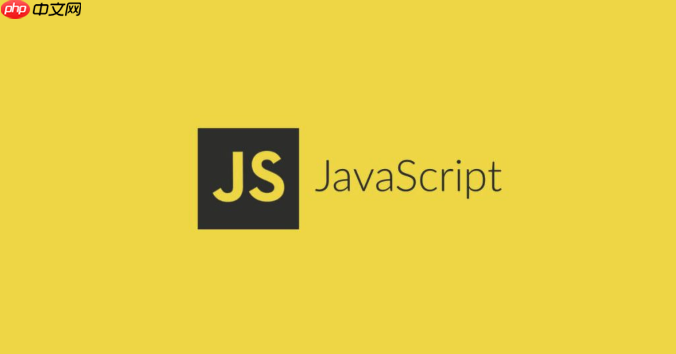可选链(?.)和空值合并运算符(??)提升了JavaScript中处理null/undefined的安全性与简洁性:可选链避免深层属性访问时的TypeError,空值合并精准设置默认值,二者结合实现安全、清晰、健壮的数据访问模式。

可选链 (
?.
??
null
undefined
TypeError
在 JavaScript 的世界里,当我们尝试访问一个不存在的属性,或者一个
null
undefined
TypeError
可选链运算符 (?.
这个运算符的出现,简直是前端开发者的福音。它允许我们安全地访问对象或数组深层嵌套的属性,而无需进行层层
null
undefined
null
undefined
undefined
想象一下以前我们怎么写:
const user = {
profile: {
address: {
street: 'Main St'
}
}
};
// 以前的写法,为了安全访问深层属性
let streetName = '';
if (user && user.profile && user.profile.address && user.profile.address.street) {
streetName = user.profile.address.street;
}
console.log(streetName); // Main St
const anotherUser = {};
let anotherStreetName = '';
if (anotherUser && anotherUser.profile && anotherUser.profile.address && anotherUser.profile.address.street) {
anotherStreetName = anotherUser.profile.address.street;
}
console.log(anotherStreetName); // '' (不会报错,但代码冗长)现在有了可选链,代码可以这样写:
const user = {
profile: {
address: {
street: 'Main St'
}
}
};
const streetName = user?.profile?.address?.street;
console.log(streetName); // Main St
const anotherUser = {};
const anotherStreetName = anotherUser?.profile?.address?.street;
console.log(anotherStreetName); // undefined (不会报错,简洁明了)
// 甚至可以用于函数调用或数组访问
const config = {
getSetting: () => 'some value'
};
const setting = config?.getSetting?.(); // 安全调用方法
console.log(setting); // some value
const dataArray = [{ id: 1 }];
const firstId = dataArray?.[0]?.id; // 安全访问数组元素
console.log(firstId); // 1
const emptyArray = [];
const nonExistentId = emptyArray?.[0]?.id;
console.log(nonExistentId); // undefined空值合并运算符 (??
这个运算符主要用于为变量提供一个默认值,但它比逻辑或运算符
||
??
null
undefined
||
false
0
''
null
undefined
NaN
这个区别在处理数字
0
''
// 以前使用 || 设置默认值的问题 const count = 0; const displayCount_old = count || 10; // 0 是假值,所以会得到 10 console.log(displayCount_old); // 10 (这里可能不是我们想要的,如果 0 是有效值) const message = ''; const displayMessage_old = message || 'Default Message'; // '' 是假值,会得到 'Default Message' console.log(displayMessage_old); // Default Message (同样,如果空字符串是有效值,这就不对了) // 使用 ?? 解决这个问题 const count_new = 0; const displayCount_new = count_new ?? 10; // 0 不是 null 或 undefined,所以得到 0 console.log(displayCount_new); // 0 (这通常是期望的行为) const message_new = ''; const displayMessage_new = message_new ?? 'Default Message'; // '' 不是 null 或 undefined,所以得到 '' console.log(displayMessage_new); // '' (同样,符合预期) const username = null; const displayUsername = username ?? 'Guest'; console.log(displayUsername); // Guest const age = undefined; const displayAge = age ?? 18; console.log(displayAge); // 18
在我看来,可选链的出现,是现代 JavaScript 语法对开发者心智负担的一次极大解放。想想看,在没有它之前,每当我们从一个接口获取数据,比如一个用户对象,里面嵌套着地址、联系方式、权限列表等等,我们为了确保程序不崩溃,总得写一堆
if (user && user.address && user.address.city)
可选链的魔力在于,它把这些繁琐的
null
undefined
undefined
TypeError
从健壮性角度看,它直接杜绝了因深层属性不存在而导致的运行时错误,大大降低了生产环境中的潜在崩溃风险。再者,从可读性上讲,代码变得异常简洁,意图也更加清晰。你一眼就能看出开发者想要访问的是哪个属性,而不是被一堆无关紧要的
if
if
||
??
这俩兄弟乍一看都像是在给变量设置默认值,但骨子里却有着根本的不同,而这个不同,正是
??
逻辑或运算符
||
null
undefined
0
''
false
NaN
0
''
||
举个例子,假设一个商品的库存数量可能是
0
||
const stock = 0; const displayStock = stock || 100; // 结果是 100,因为 0 是假值
这里,
0
||
100
而空值合并运算符
??
null
undefined
0
''
false
NaN
??
因此,当你需要为变量提供默认值,并且希望
0
''
false
??
||
0
''
??
在日常开发中,可选链和空值合并运算符常常是“搭档”出现,它们一起构建了一种非常优雅、安全且高效的数据访问模式。这种组合在处理从后端获取的、结构可能不完全确定的数据时尤其强大。
设想一个场景:我们正在开发一个用户详情页面,需要展示用户的联系方式。这个联系方式可能深藏在
user.profile.contact.phone
profile
contact
phone
null
undefined
phone
null
undefined
传统的写法可能长这样:
const userData = {
id: 1,
name: '张三',
profile: {
address: '北京',
contact: {
email: 'zhangsan@example.com'
// phone 字段可能不存在
}
}
};
let userPhone = '暂无电话';
if (userData && userData.profile && userData.profile.contact && userData.profile.contact.phone) {
userPhone = userData.profile.contact.phone;
}
console.log(userPhone); // 暂无电话
// 另一个例子,phone存在但为null
const userData2 = {
id: 2,
name: '李四',
profile: {
address: '上海',
contact: {
email: 'lisi@example.com',
phone: null
}
}
};
let userPhone2 = '暂无电话';
if (userData2 && userData2.profile && userData2.profile.contact && userData2.profile.contact.phone) {
userPhone2 = userData2.profile.contact.phone;
}
console.log(userPhone2); // 暂无电话 (同样冗长)而结合可选链和空值合并运算符,我们可以这样写:
const userData = {
id: 1,
name: '张三',
profile: {
address: '北京',
contact: {
email: 'zhangsan@example.com'
// phone 字段可能不存在
}
}
};
// 简洁且安全地获取电话,如果不存在或为 null/undefined,则使用默认值
const userPhone = userData?.profile?.contact?.phone ?? '暂无电话';
console.log(userPhone); // 暂无电话
// 另一个例子,phone存在但为null
const userData2 = {
id: 2,
name: '李四',
profile: {
address: '上海',
contact: {
email: 'lisi@example.com',
phone: null
}
}
};
const userPhone2 = userData2?.profile?.contact?.phone ?? '暂无电话';
console.log(userPhone2); // 暂无电话
// 假设电话号码是 0 (比如某种内部编码)
const userData3 = {
id: 3,
name: '王五',
profile: {
address: '广州',
contact: {
email: 'wangwu@example.com',
phone: 0
}
}
};
const userPhone3 = userData3?.profile?.contact?.phone ?? '暂无电话';
console.log(userPhone3); // 0 (正确地保留了 0 这个有效值)这种模式的强大之处在于:
?.
profile
contact
TypeError
undefined
??
?.
undefined
null
null
'暂无电话'
0
''
通过这种组合,我们不仅大大减少了代码量,提升了可读性,更重要的是,它构建了一个异常鲁棒的数据访问路径,让我们的应用在面对各种不确定数据时,依然能够稳定运行,并提供友好的用户体验。这在处理大型、复杂的数据模型时,简直是提升开发效率和代码质量的利器。
以上就是什么是可选链和空值合并运算符,以及它们如何简化深层对象访问和默认值处理?的详细内容,更多请关注php中文网其它相关文章!

每个人都需要一台速度更快、更稳定的 PC。随着时间的推移,垃圾文件、旧注册表数据和不必要的后台进程会占用资源并降低性能。幸运的是,许多工具可以让 Windows 保持平稳运行。

Copyright 2014-2025 https://www.php.cn/ All Rights Reserved | php.cn | 湘ICP备2023035733号